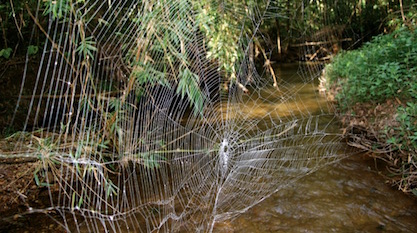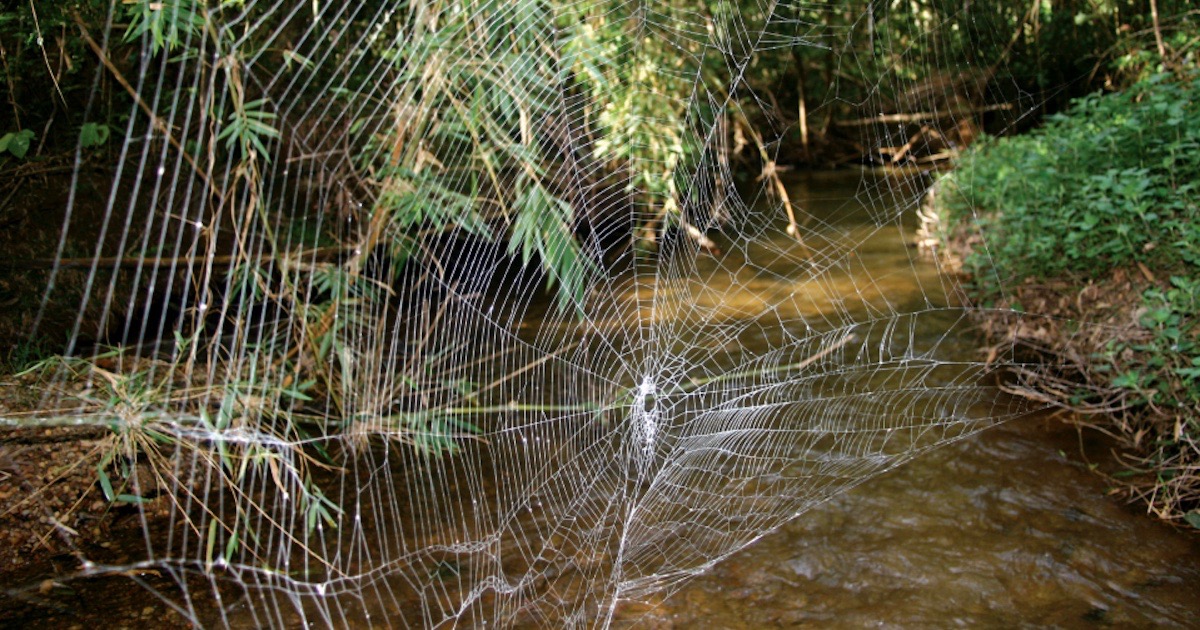 Intelligent Design
Intelligent Design
 Life Sciences
Life Sciences
From Freakout to Admiration: Why Spiders Should Inspire Us


You’re sitting at your computer reading your friend’s latest Facebook post, when all of a sudden a teensy-weensy spider comes dangling on its silk thread between you and the screen. A typical reaction is to shriek and smash it between two books as fast as you can. But if you’re a good citizen scientist, you might pause to ask some questions about what you are witnessing. Here are some suggestions: (1) How can that tiny body put out that much material? (2) How can that hair-like thread carry so much weight without breaking? (3) Why doesn’t the spider spin out of control as the thread lengthens?
Great discoveries are made with this kind of curiosity. Scientists at the American Institute of Physics looked into that third question recently.
The last time you watched a spider drop from the ceiling on a line of silk, it likely descended gracefully on its dragline instead of spiraling uncontrollably, because spider silk has an unusual ability to resist twisting forces.
In a new paper appearing this week in Applied Physics Letters, from AIP Publishing, researchers from China and the U.K. showed that unlike human hair, metal wires or synthetic fibers, spider silk partially yields when twisted. This property quickly dissipates the energy that would otherwise send an excited spider spinning on the end of its silk.
“Spider silk is very different from other, more conventional materials,” said Dabiao Liu of Huazhong University of Science and Technology. “We find that the dragline from the web hardly twists, so we want to know why.” [Emphasis added.]
The paper says in standard Darwinian fashion that spider silk has been “optimized by millions of years of evolution” — but for that to be true, every spider that didn’t accidentally get the unique properties of silk just right had to die off in the struggle for existence. We’re glad the scientists didn’t dwell on the narrative gloss but, instead, ran some clever experiments. By hanging washers from silk gathered by captive spiders, they measured silk’s torsional (twisting) properties with a Cavendish balance — the same device Henry Cavendish used to weigh the earth in the 1790s. What they found is that the silk deforms slightly when twisted, absorbing about 75 percent of the potential energy and damping the rotational oscillations that would normally result. Here’s what’s required for that trait:
The team suspects that this unusual behavior is linked to the silk’s complex physical structure, consisting of a core of multiple fibrils inside a skin. Each fibril has segments of amino acids in organized sheets and others in unstructured looping chains. They propose that torsion causes the sheets to stretch like elastic, and warp the hydrogen bonds linking the chains, which deform like plastic. The sheets can recover their original shape, but the chains remain partially deformed. The pendulum exhibits this change with reduced magnitude of the silk’s oscillations, as well as a shifting of the equilibrium point of the oscillation.
Isn’t a design view more satisfying than an accidental view? “This spider silk is displaying a property that we simply don’t know how to recreate ourselves, and that is fascinating,” they say, as visions of biomimetic products loomed in their eyes. Maybe we could make parachute cords, violin strings, and helicopter rescue ladders that behave like this, the news item suggests.
Tension, Torsion, and Invention
The twist-resistant behavior is the latest in a list of desirable properties in spider silk that make it an icon of bio-inspiration. The paper in Applied Physics Letters says that spider silk “has attracted tremendous attention due to its remarkable mechanical properties including high strength and great extensibility, supercontraction, and exceptional thermal conductivity.”
Most of the attention to date has focused on silk’s tensional properties. Spider silk is extremely strong for its diameter. “In ancient Rome, spider webs were used to dress soldiers’ battle wounds,” news from KTH, The Royal Institute of Technology relates. But producing large quantities of this bioactive material has been an expensive challenge.
In May, researchers at KTH announced that artificial silk could be strengthened and made in a cheap and sustainable way by adding wood nanocellulose to it. “The strength of the fiber is significantly better than any man-made, silk-based material to our knowledge, and on the same level as what can be found in nature from spiders,” one of the researchers boasted. Fortunately, they don’t have to become spider ranchers to get the silk. They use bacteria programmed with the silk genes, then purify the product in the lab and combine it with tiny wood chips. Artificial ligaments, flexible and strong, might come from this advance.
Another way of imitating spider silk was announced by the University of Cambridge this month. Bypassing silk genes altogether, the researchers “have designed a super stretchy, strong and sustainable material that mimics the qualities of spider silk, and is ‘spun’ from a material that is 98% water.” Emphasis on “designed.” This new “green” method of production requires no toxic substances and yields thin fibers with many of the desirable characteristics of spider silk:
A team of architects and chemists from the University of Cambridge has designed super-stretchy and strong fibres which are almost entirely composed of water, and could be used to make textiles, sensors and other materials. The fibres, which resemble miniature bungee cords as they can absorb large amounts of energy, are sustainable, non-toxic and can be made at room temperature.
A video clip in the article shows how they extrude the hydrogel, composed of silica and cellulose bound with molecular “handcuffs” into thin strands a few millionths of a meter in diameter.
When the water evaporates, a fiber is left that is strong and stretchy. Their paper in the Proceedings of the National Academy of Sciences boasts that their “bioinspired” silk has similar tension properties to natural spider silk and is able to dampen vibrations by a similar amount. The articles don’t mention if the artificial silk avoids spinning out of control when a load is placed on it, of if their machine can lay eggs and grow new machines.
Silk to Save Preemies
In another surprise application inspired by spider silk, researchers at the Karolinska Institute “have managed to synthesise lung surfactant, a drug used in the care of preterm babies, by mimicking the production of spider silk.” This can replace the current surfactant drugs used to help preemies inflate their lungs. Who would have thought that careful observation of spiders would lead to biological drugs!
The latest Spider-Man movie came out July 7, but maybe the real superhero we should admire is not the Man but the Spider that produces such amazing material. After decades of work, scientists are starting to imitate some of silk’s wonderful properties, but not all of them simultaneously. So slow down just a little bit before squashing the living architect whose secretions may revolutionize medicine, defense, and safety.
We began with a teensy-weensy spider, but let’s end with a big one. Live Science posted a re-released video from the BBC about a relatively “small, inconspicuous” spider discovered in Madagascar in 2009 with an Olympic-level feat: the ability to “spray” its web 25 meters (up to 82 feet) across a river.
“How a spider, no bigger than a thumbnail, can produce so much silk so quickly has baffled scientists,” David Attenborough says. “And it’s no ordinary silk,” he adds. “It’s the toughest natural fiber on the planet — tougher than steel.” And the spider can use it for food!
The little spider proceeds to build the world’s largest web, up to 2 meters wide, big enough to arouse shudders in those horrified at the hobbits’ encounter with Shelob in Lord of the Rings. At least the prey in this nature clip, promptly shrink-wrapped by the spider, is a little mayfly we would probably swat anyway. Someone else deserves a good swat. It’s whoever named this amazing species “Darwin’s bark spider” (Caerostris darwini). He had nothing to do with it.
Photo: Web spun by Darwin’s bark spider, by Ingi Agnarsson, Matjaž Kuntner, Todd A. Blackledge [CC BY 2.5], via Wikimedia Commons.
